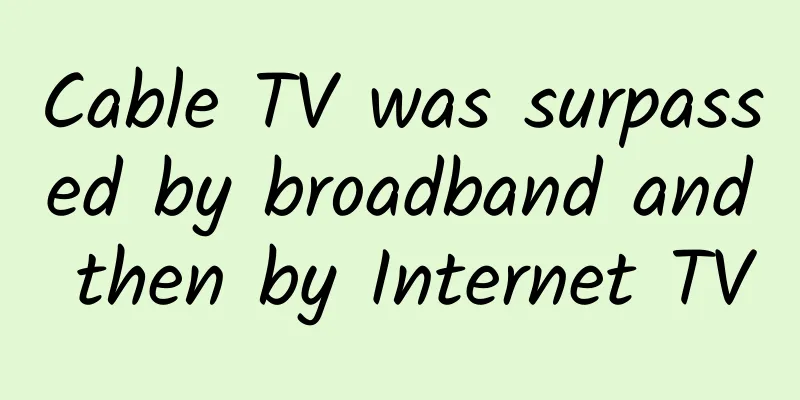Cable TV was surpassed by broadband and then by Internet TV

|
Cable TV was once the largest form of home entertainment. Whether in China or the United States, cable TV had grown to a record 260 million households across the country by the end of 2016. However, statistics by mid-2017 showed that only about two-thirds of these paying users had renewed their subscriptions, and more than one-third of cable TV users no longer had or did not plan to renew their subscriptions! Why? Because of broadband. By the first half of 2017, China's household fixed broadband users had exceeded 330 million, including 120 million for China Telecom, more than 80 million for China Mobile, and less than 80 million for China Unicom. Cable TV network companies in various regions have a total of about 30 million households, and private local broadband operators such as Dr. Peng, Founder, and AP have about 30 million households. In the Chinese market, broadband has surpassed cable TV to become the number one form of entertainment for households, and broadband-bundled IPTV is approaching the 100 million household mark, including more than 60 million households for China Telecom and more than 30 million households for China Unicom. The number of OTT Internet TV users given away by China Unicom has also exceeded that of Unicom IPTV, reaching around 40 million households. In addition to the IPTV and OTT terminals bundled and given away by the three major operators, a number of Internet TV set-top box manufacturers such as LeTV and Xiaomi have produced and sold more than 100 million Internet TV set-top boxes. Since 2011, nearly 200 million smart TVs that can access the Internet directly have been sold, and the remaining 300 million old CRT TVs or feature flat-screen TVs are being updated at a rate of 40-60 million units per year. In other words, there should be 200-300 million households with Internet TV set-top boxes + smart TVs in the Chinese market, and regardless of their current activation rate and activity rate, they are all within the coverage of the 330 million broadband users, although the actual number is still a Sphinx mystery. But in the United States, this is not a mystery! According to foreign media reports, streaming services have completely subverted the entire entertainment industry, among which the online movie rental service Netflix has had the greatest impact. In the past five years, the number of Netflix users in the United States has doubled. Now, Netflix has achieved another major victory in its competition with the largest cable TV providers in the U.S. Research results show that Netflix's number of U.S. users has reached 50.85 million, exceeding the total number of users of the largest cable TV companies in the U.S. (48.61 million). Netflix announced the above user figures in its latest quarterly earnings report. The cable industry figures come from a research report released last month by Leichtman Research Group, a well-known market research company. The report estimates the total number of American users of the six major cable TV companies in the United States. These six major cable TV companies, including Comcast (with 22.5 million American users) and Charter Communications (with 17.1 million American users), are the main pillars of the American cable TV industry. Of course, we don’t take into account the number of subscribers to U.S. satellite TV companies, let alone the number of viewers to U.S. broadcast TV companies, when determining Netflix’s victory. But the above figures still represent a very important milestone in Netflix’s development in the competition with traditional TV companies. Leichtman Research Group estimates that the six largest cable companies lost more than 100,000 subscribers in the most recent quarter, while in April Netflix said it had added 1.4 million U.S. subscribers in the same period. While cable companies worry about further losses, Netflix is confident that its subscriber numbers will continue to grow. When Netflix announces second-quarter earnings next month, its U.S. subscribers could reach 51.5 million. Although Netflix's user growth rate has not always satisfied shareholders, its market share is still far ahead of its competitors, capturing about three-quarters of streaming users. Netflix is also expanding rapidly in overseas markets. In recent years, its service has been promoted to more than 190 countries around the world. In the earnings conference call next month, Netflix is expected to announce that its global user base has finally exceeded 100 million. Netflix isn't the only streaming service growing in number of users. Competitors like Amazon, Hulu and Google's video site YouTube are also constantly gaining market share and challenging Netflix's dominance. Why is OTT becoming more and more competitive? It is because it has better functions, more content and better user experience than traditional broadcast TV DVB, which is the magic weapon for product competition. There are still 50 million analog cable TV users in China, which only have one-way TV channel broadcasts. Among the remaining 210 million digital cable TV users, only 60 million are high-definition interactive digital cable TV users that can time-shift, rewind and watch on demand. The remaining 150 million digital cable TV users are one-way digital, and apart from DVB, they only have NVOD. Although the IPTV given away with broadband installation by China Telecom and China Unicom cannot compete with high-definition interactive digital cable TV, it can easily outnumber the 50 million analog cable TV users and 150 million one-way digital cable TV users. Therefore, if cable TV network companies do not promote high-definition interactive digitalization as soon as possible, IPTV will still have room for growth. OTT user experience is better. It is free from the dedicated line access and private network platform of DVB and IPTV, and runs freely on the public Internet. Especially for smart TVs, the user experience is the best. You can directly enter the home page when you turn on the TV, and then switch the source and enter the DVB box, IPTV box or OTT box. As long as it is operated properly, the box will be an excessive product that will be swept into the garbage dump, except for some specific uses in certain segments. For example, the recently popular "Alien: Covenant" makes me want to watch "Alien 1, 2, 3, 4" and "Prometheus" again. It is too uncomfortable to watch it on a mobile phone. Mobile phones are only suitable for short videos. A 2-hour movie, including sound effects, is more suitable and comfortable to watch on TV. But this option is basically impossible to achieve on DVB and IPTV. Taking the CAN TV that @南皮老尹 gave me as an example, I did not subscribe to cable TV, but directly used the wifi connected to the Kanshang smart TV, searched in the movie category, and downloaded Pumpkin Movie, Tencent Cloud Audio-visual and iQiyi's Qiyiguo from the Kanshang App Store. Some are free, while others require membership fees. However, payment is also very simple, just scan with WeChat or Alipay. The price is about the same as that of a few movie tickets at the cinema, but there is a huge amount of content that can be freely selected on demand. I am in charge of my own time, and this is the competitiveness of OTT. But not all OTTs do well because of updating and operation. That’s why people still like live streaming. Whether you like the channel or not, there are at least 300 channels for you to choose from, and there are about 4,000 channels in total. Every moment you turn on the TV, you see different content, which is fresh and unknown. Just like GUMP said in "Forrest Gump", you don’t know what the next chocolate will taste like. This is the charm of live streaming. On the other hand, with some OTT operators, the interface you open is almost the same within a week or even a month. After the initial one or two months of novelty and after you have collected all the movies in it, the box is basically abandoned. It is not like a smart TV, where at least you turn it on first and then switch the signal source to the DVB or IPTV box. Therefore, there is no hope in making boxes, including DVB boxes and IPTV boxes. The future will be in smart TVs. In fact, the operation itself does not mean that the newer the copyright, the better. What matters is difference and freshness. This is the supreme rule for all content operators. Whether it is Weibo, Moments, or Toutiao, there is new content every second, and you have the motivation and desire to keep refreshing. The key lies in the arrangement. I believe that many old films and classic movies have not been seen by everyone, and it is not the case that once you have seen them, you can no longer watch them, just like the old man watching "Alien". The terminal is only a traffic entrance, and the core is still content. In the past, content was broadcast linearly on DVB, and later content was available for users to watch on demand on IPTV & OTT. In the future, content will rely on AI to capture, aggregate and automatically present. This is a change in communication. As a winner of Toutiao's Qingyun Plan and Baijiahao's Bai+ Plan, the 2019 Baidu Digital Author of the Year, the Baijiahao's Most Popular Author in the Technology Field, the 2019 Sogou Technology and Culture Author, and the 2021 Baijiahao Quarterly Influential Creator, he has won many awards, including the 2013 Sohu Best Industry Media Person, the 2015 China New Media Entrepreneurship Competition Beijing Third Place, the 2015 Guangmang Experience Award, the 2015 China New Media Entrepreneurship Competition Finals Third Place, and the 2018 Baidu Dynamic Annual Powerful Celebrity. |
<<: US official: Tesla battery reignites twice after fatal crash
Recommend
What is Tik Tok SEO? Uncovering the working principle and recommendation algorithm of TikTok search algorithm
Because I wrote an article called "SEO Think...
Amap launches AR driving navigation: try real-scene navigation on your mobile phone!
Although map navigation is now very popular, peop...
What is the process of paying deposit for Douyin store? What are the conditions for opening a Douyin store?
This article mainly introduces the process of pay...
In just one day, two gophers transformed a volcano
The impact lasts for decades. On May 18, 1980, Mo...
“Pull out one grey hair and 10 will grow back”, is it true?
White hair always lurks on our heads silently. If...
Do people sigh after death? This is how corpses "speak"...
Expert of this article: Fan Xiaomeng, a forensic ...
Huawei Qiankun Intelligent Driving helps the city and the wild, smart and brave hardcore SUV Fangcheng Baobao 8 to be launched
On November 12, BYD and Huawei jointly launched t...
Advertisers’ new song: the future of programmatic business model
Looking ahead to the programmatic future, which i...
Social media has made advertising no longer a “one-time investment” thing!
Advertising is not as simple as finding a media o...
After the "disruption" wave, traditional TV manufacturers are forced to run fast
In the past two years, as more and more Internet ...
Strategy Analytics: Global 5G smartphone shipments are expected to reach 199 million in 2020
Strategy Analytics' latest research report po...
The Great Voyage丨Sheepskin Raft on the Yellow River: Can sheepskin be “blown”?
Entering the Maritime History Museum of the China...
Come, count how many birds are there in this picture?
Not long ago, Guokr held a Youth Forum with the t...
The number one symptom of “crispy workers” and “crispy college students” may also exist in you!
In recent times, many people have claimed to be d...
8 promotion and monetization techniques, which one do you pick?
Today I will share with you the 8 most common mon...









